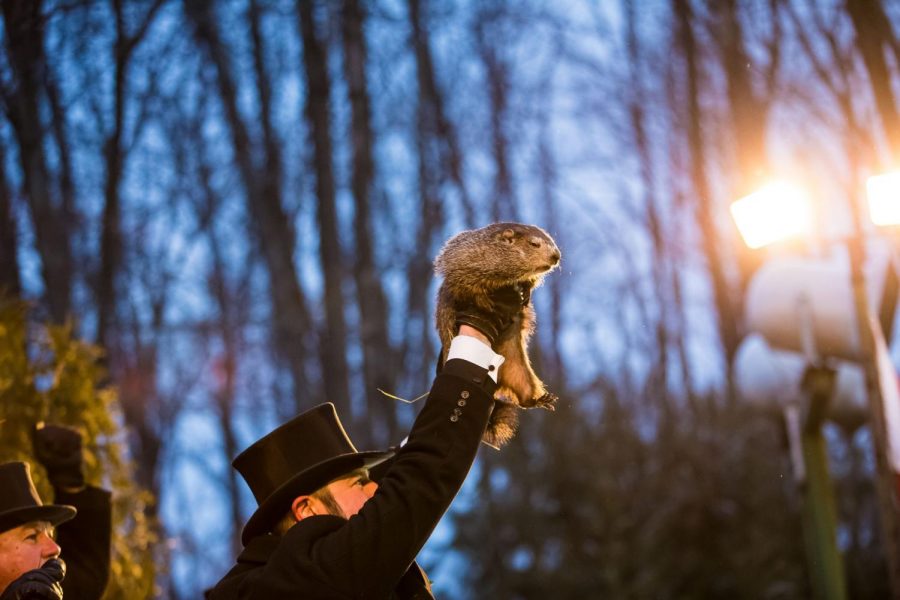Punxsutawney Phil’s Forecasts
A few weeks ago on Feb. 2, a crowd of people in Punxsutawney, PA, watched as a man pulled a groundhog named Punxsutawney Phil from a log.
Phil did not see his shadow and forecast an early spring.
To a foreigner, that paragraph may sound like complete nonsense. To many Pennsylvanians and other Americans, though, it is a description of the popular tradition known as Groundhog Day.
Despite being a native Pennsylvanian, I found myself asking some questions this past Groundhog Day.
How did this unusual tradition get started? Why does Phil predict six more weeks of winter if he sees his shadow and an early spring if he does not? How accurate a prognosticator could a groundhog even be? With spring break fast approaching, would there be an early spring?
I soon went down the rabbit hole (or rather, groundhog hole) to find answers.
Groundhog Day can be traced back to several German or European traditions and beliefs. The oldest go back to the Middle Ages, according to the Encyclopedia Britannica. During the Middle Ages, the belief arose that in the beginning of February, hibernating animals would wake up and leave their dens. A sunny day, which was taken to forecast a long winter, would cause the animal to cast a shadow. A cloudy day, and thus no shadow, was interpreted as a sign of upcoming fair weather.
These Middle Age beliefs can be connected to the Catholic festival of Candlemas.
Candlemas took place on Feb. 2, and also had a method for predicting the weather. There were no animals involved, but an English folk song “highlights…weather prognostication,” according to The Punxsutawney Groundhog Club. “If Candlemas be fair and bright / Come, Winter, have another flight / If Candlemas brings clouds and rain / Go Winter, and come not again,” the song goes.
Candlemas soon became celebrated by the German Protestant church. The Germans combined the Candlemas tradition with the Middle Age belief. They used badgers, hedgehogs, and even bears as their weather forecasters, according to the PGC.
However, badgers and hedgehogs are not as common in America, so the German immigrants to Pennsylvania, commonly known as the Pennsylvania Dutch, had to find a new animal.
In Germany, the badger was known as the “dachs.” The similar sounding “dox,” or groundhog, was used in Pennsylvania. The well-known “six more weeks of winter” and “early spring” were started by the Pennsylvania Dutch as well.
The first year that Groundhog Day appeared in a local Punxsutawney, PA, newspaper was 1886. The first official Groundhog Day, though, took place the following year when the locals journeyed to the Gobbler’s Knob part of town to consult a groundhog.
Ever since then, people have flocked to Gobbler’s Knob to be a part of the Groundhog Day tradition.
How accurate are Phil’s forecasts though?
Turns out they’re not that accurate. His predictions may be good for a groundhog, but they aren’t the most accurate.
The PGC’s own records of Phil’s predictions show that he has made 103 forecasts of six more weeks of winter and 19 forecasts (including this year’s) of an early spring. Using the Stormfax Almanac’s weather data, Phil’s six-week forecasts have been correct only 39 percent of the time. Phil’s accuracy drops further to 36 percent when compared against actual weather outcome data from 1969 onward.
However, his accuracy when it comes to early spring predictions is slightly better. According to meteorologist Tim Roche, Phil has a “47 percent accuracy rate” for early spring predictions.
Even with that small improvement, Phil’s predictions cannot be considered accurate. Both accuracy rates are less than the “60 percent accurate or higher” rate that the National Weather Service uses as a threshold value to consider whether an estimate is good or not, according to NWS meteorologist David Unger. I’ll rely on The Weather Channel’s forecasts, instead.
As for Phil’s prediction of an early spring this year, the Weather Channel doesn’t agree. Its 10-day forecast for the area of Bethlehem predicts that temperatures will stay under 50 degrees throughout spring break, with rain and even snow possible for a few days.
Phil may not be the most accurate prognosticator, but he has provided us with the fascinating tradition of Groundhog Day. We also got a pretty good Bill Murray movie out of it, too.







